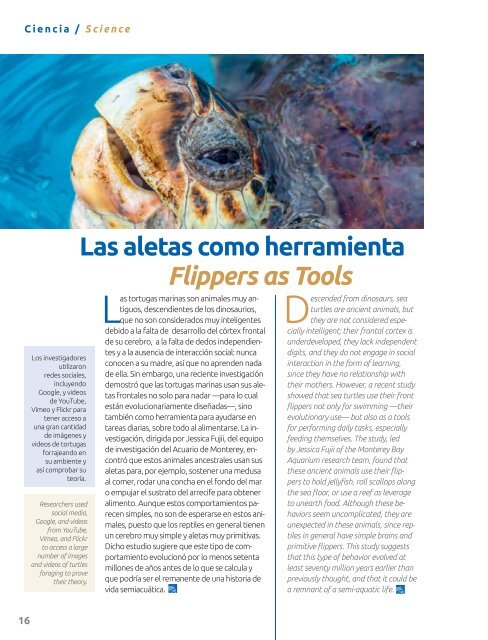You also want an ePaper? Increase the reach of your titles
YUMPU automatically turns print PDFs into web optimized ePapers that Google loves.
C iencia / Science<br />
Los investigadores<br />
utilizaron<br />
redes sociales,<br />
incluyendo<br />
Google, y videos<br />
de YouTube,<br />
Vimeo y Flickr para<br />
tener acceso a<br />
una gran cantidad<br />
de imágenes y<br />
videos de tortugas<br />
forrajeando en<br />
su ambiente y<br />
así comprobar su<br />
teoría.<br />
Researchers used<br />
social media,<br />
oogle, and videos<br />
from YouTube,<br />
Vimeo, and Flickr<br />
to access a large<br />
number of images<br />
and videos of turtles<br />
foraging to rove<br />
their theory.<br />
Las aletas como herramienta<br />
Flippers as Tools<br />
Las tortugas marinas son animales muy antiguos,<br />
descendientes de los dinosaurios,<br />
que no son considerados muy inteligentes<br />
debido a la falta de desarrollo del córtex frontal<br />
de su cerebro, a la falta de dedos independientes<br />
y a la ausencia de interacción social: nunca<br />
conocen a su madre, así que no aprenden nada<br />
de ella. Sin embargo, una reciente investigación<br />
demostró que las tortugas marinas usan sus aletas<br />
frontales no solo para nadar —para lo cual<br />
están evolucionariamente diseñadas—, sino<br />
también como herramienta para ayudarse en<br />
tareas diarias, sobre todo al alimentarse. La investigación,<br />
dirigida por Jessica Fujii, del equipo<br />
de investigación del Acuario de Monterey, encontró<br />
que estos animales ancestrales usan sus<br />
aletas para, por ejemplo, sostener una medusa<br />
al comer, rodar una concha en el fondo del mar<br />
o empujar el sustrato del arrecife para obtener<br />
alimento. Aunque estos comportamientos parecen<br />
simples, no son de esperarse en estos animales,<br />
puesto que los reptiles en general tienen<br />
un cerebro muy simple y aletas muy primitivas.<br />
Dicho estudio sugiere que este tipo de comportamiento<br />
evolucionó por lo menos setenta<br />
millones de años antes de lo que se calcula y<br />
que podría ser el remanente de una historia de<br />
vida semiacuática.<br />
Descended from dinosaurs, sea<br />
turtles are ancient animals, but<br />
they are not considered especially<br />
intelligent; their frontal cortex is<br />
underdeveloed, they lack indeendent<br />
digits, and they do not engage in social<br />
interaction in the form of learning,<br />
since they have no relationshi with<br />
their mothers. However, a recent study<br />
showed that sea turtles use their front<br />
fliers not only for swimming their<br />
evolutionary use but also as a tools<br />
for performing daily tasks, especially<br />
feeding themselves. he study, led<br />
by Jessica Fujii of the Monterey Bay<br />
uarium research team, found that<br />
these ancient animals use their fli-<br />
ers to hold ellyfish, roll scallos along<br />
the sea floor, or use a reef as leverage<br />
to unearth food. Although these behaviors<br />
seem uncomlicated, they are<br />
unexpected in these animals, since reptiles<br />
in general have simle brains and<br />
rimitive fliers. his study suggests<br />
that this tye of behavior evolved at<br />
least seventy million years earlier than<br />
reviously thought, and that it could be<br />
a remnant of a semiauatic life.<br />
16



